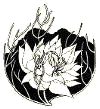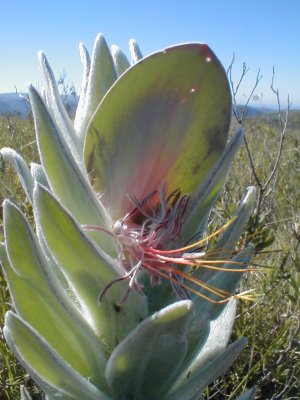
Home
Mission
Overview of Project
Project Staff
Sponsors
Achievements
Checking, Illustrations
Upcoming Activities
Id and Species Lists
Protea Information
Protea Gallery
Growing Proteas
Interim Dist. Maps
Publications
Afrikaanse Inligting
![]()
Mimetes "vinigaremontana" discovered in the Suurberg Mountains, near PE
 This story took 6 months to
develop. It started out with a Protea Atlas field trip to the Eastern Cape in March 2001,
immediately after the AGT at Villiersdorp. Tony Rebelo, Pindar Sidisunthorn, Simon Gardner
and I made up the party.
This story took 6 months to
develop. It started out with a Protea Atlas field trip to the Eastern Cape in March 2001,
immediately after the AGT at Villiersdorp. Tony Rebelo, Pindar Sidisunthorn, Simon Gardner
and I made up the party.
My main interest, other than, of course, the politically correct one of "Protea Atlassing", was to see the Pondoland Streambush Ld pondonese and Dwarf Grassland Sugarbush Pr simplex, the last two species I needed to compete my atlassing of all South Africa’s proteas (except of course Ld climacticum, but that is another story). [And Se delphiniifolia – yet another story Ed.]. Our trip therefore took us to the Transkei where we soon found Pr simplex on the Lusikisiki plain between this village and the sea, on the undulating sandstone hills. The Common Sugarbush Pr caffra caffra and Natal Spear-leaf Conebush Ld spissifolium natalense were also atlassed. We were really pleased to find Pr simplex on the plain because its exact localities in the Transkei coast were not known to the Protea Atlas Project. Unfortunately we didn’t find any Ld pondense near Lusikisiki but Tony did get a southerly range extension. We visited the Mkambati Nature Reserve, where I found a population of Ld pondoenese in a river course in the reserve that hadn’t been atlassed before, so I was pleased. Even though, Tony kept me in suspense until mid morning on the last official atlas day of 31 March 2001. He said it was an error, he did not know it occurred there, as he was hoping to keep the species until 18h00, about half an hour after sunset! The habitat of this Conebush is rather interesting in that it is quite easy to look at a plot in the distance and say "Yes, it will be there" or "No, it won’t be there" and there is an excellent chance you will be right. Ld pondoenese requires a river, sandstone, ideally a few rocks around and a river bank which cannot be too shallow or too steep. This is because the plant is a reseeder and cannot survive in an area of too-frequent fire (river bank shallow) or too infrequent fire (river bank steep or too much of a gorge). Plants can be very clever about where they grow and don’t grow! Tony found a population of Pondoland Pincushion Ls innovans, which was really exciting because it is quite rare and vulnerable.
Before we arrived in the Transkei we did a lot of atlassing in the Suurberg Mountains near Port Elizabeth. These mountains used to be the Suurberg National Park, but they are in the process of being joined up with the Addo Elephant National Park under the latter name. These mountains are quite inaccessible apart from a few passes crossing them. However, there are a few vague tracks along the tops and so Witblits, our Mazda 4X4, transcended the heights. We also did some stunning 4X4 routes, atlassing the biggest Wart-stem Pincushion Ls cuneiforme you ever did see. You thought SASOL Proteas was mistaken when it said a tree to 3m? Well, you better believe it. At a distance they looked like the Green Tree Pincushion Ls conocarpodendron or the Red Edge Conebush Ld crassulaefolium. We drove through the rhino enclosures (didn’t see one though) and atlassed alongside a mean electric fence (no proteas will get through that!). The rustic campsite on the Banks of the Sundays River looks stunning. So does the luxury hut at Kabouga. Definitely worth a visit! Go there before it becomes developed – it is a true wilderness experience!
And now for my story. It was on one of these hilltop morning tea stops in the Suurberg. I was really pleased to see the Leafy Sugarbush Pr foliosa flowering, so I naturally went and photographed it while the others were loafing in the grassland with their coffee. It had been rather boring up until then – we had only seen Ld salignum and Ls cuneiforme (normal non-tree form). There had been some herds of hartebeest and zebra but we were after more important things. Oh, and a lot of cycads, and Tony made us atlas Rabbits Ears Oldenberghia grandis as well, probably because there were not enough other proteas to keep us busy.
 Anyway,
on my return, Tony asked me to photograph a daisy that is known to fool the occasional
unsuspecting atlasser because it is a protea "look-alike". I innocently obliged
and walked around the plants looking for a nice specimen. The others continued with tea,
but Tony called out to look out for one that "might perhaps be in flower." There
were fields of the daisy, but about 30m way one that was in flower immediately caught my
eye. I moved around, selecting the best angle and lighting, and took a series of
photographs. Simon chirped up: "Doesn’t it look a bit like a protea,
Nigel?". I agreed, and continued photographing. Meanwhile Tony, Pindar and Simon were
laughing their heads off inside, but I was photographing and did not notice. Unknown to
me, Simon had removed a single flowerhead from a Mi argenteus
Silver Pagoda on Blokkop at the AGT the week before and had found it – in
perfect nick - in his pocket. While I was photographing the Leafy Sugarbush Tony had
sneaked it into one of the thousands of Helichrysum plants on the hillside and
expertly placed in the plant. Well, when I stood up and turned around to go and enjoy my
tea break, Tony, Simon and Pindar nearly split their sides. It delayed atlassing for some
while before the trio regained their compose enough to explain to me what they were
laughing about. Simon went and got the flowerhead to rub it in deep. And the rest of the
day was disrupted by inane comments every time we saw the Everlastings, and they were
everywhere!
Anyway,
on my return, Tony asked me to photograph a daisy that is known to fool the occasional
unsuspecting atlasser because it is a protea "look-alike". I innocently obliged
and walked around the plants looking for a nice specimen. The others continued with tea,
but Tony called out to look out for one that "might perhaps be in flower." There
were fields of the daisy, but about 30m way one that was in flower immediately caught my
eye. I moved around, selecting the best angle and lighting, and took a series of
photographs. Simon chirped up: "Doesn’t it look a bit like a protea,
Nigel?". I agreed, and continued photographing. Meanwhile Tony, Pindar and Simon were
laughing their heads off inside, but I was photographing and did not notice. Unknown to
me, Simon had removed a single flowerhead from a Mi argenteus
Silver Pagoda on Blokkop at the AGT the week before and had found it – in
perfect nick - in his pocket. While I was photographing the Leafy Sugarbush Tony had
sneaked it into one of the thousands of Helichrysum plants on the hillside and
expertly placed in the plant. Well, when I stood up and turned around to go and enjoy my
tea break, Tony, Simon and Pindar nearly split their sides. It delayed atlassing for some
while before the trio regained their compose enough to explain to me what they were
laughing about. Simon went and got the flowerhead to rub it in deep. And the rest of the
day was disrupted by inane comments every time we saw the Everlastings, and they were
everywhere!
Back at Cape Town I sent Tony the perfect picture, suitably inscribed with undeleted expletive symbols. Tony suggested that we include it (minus expletives) in a Protea Atlas Project website competition. With the option that this plant was a newly discovered Pagoda called Mimetes vinigaremontana (because of the Suurberg Mountains). Have a look at the web competition at www.nbi.ac.za/protea and follow the links to the web competition. I bet you would have been fooled too. Fools!
Oh well, I saw the two proteas I wanted to see on this trip but wow, what a lot of penance I had to go through. Not only did I go through the photographic joke, but also endless reminders in the Suurberg Mountains, which are not very interesting from a Protea point of view. There is lots of Ld salignum and Ls cuneiforme, some Pr foliosa and not much else. [Don’t forget the Mi vini – there was lots of that too - Eds] There was always great excitement whenever we found Pr lorifolia, repens and cynaroides.
And why did the story take 6 months to develop? Because the photograph of Mi vinigaremontana was used in a competition on the website and this article couldn’t be written before the competition was completed. {And no one was brave enough to take a guess and Nigel had to look at the picture for another quarter. Tee Hee! Eds}
Nigel Forshaw, Oakridge
Back PAN 52